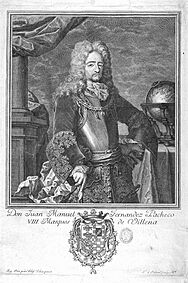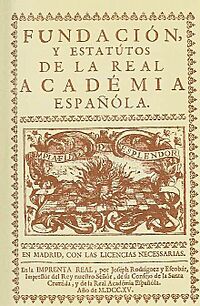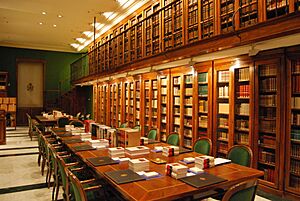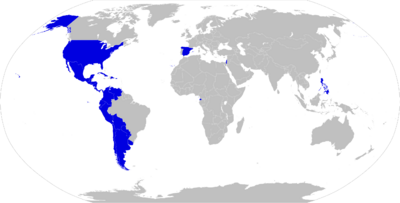Royal Spanish Academy facts for kids
|
Real Academia Española
|
|

Arms of the Royal Spanish Academy
|
|
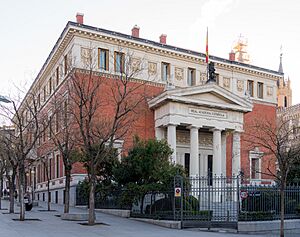
Headquarters of the Royal Spanish Academy on Felipe IV Street, 4, in the Jerónimos neighborhood of Madrid.
|
|
| Abbreviation | RAE |
|---|---|
| Formation | 1713 |
| Founder | The Duke of Escalona |
| Purpose | Linguistic prescription and research |
| Headquarters | Madrid, Spain |
|
Region served
|
Hispanophone regions and populations |
|
Official language
|
Spanish |
|
Protector
|
Felipe VI (as King of Spain) |
|
Director
|
Santiago Muñoz Machado |
|
Main organ
|
Governing Board |
| Affiliations | Association of Spanish Language Academies |
The Royal Spanish Academy (Spanish: Real Academia Española, often called RAE) is Spain's official organization for the Spanish language. Its main job is to make sure the Spanish language stays strong and united. The RAE is located in Madrid, Spain. It works closely with other Spanish language academies in 22 different countries where Spanish is spoken. These academies are part of the Association of Spanish Language Academies.
The RAE helps guide how the Spanish language is used. It creates rules and suggestions to keep the language consistent across all Spanish-speaking areas. This helps everyone understand each other. The RAE shares these language guidelines in many books and publications.
Contents
History of the RAE
In 1711, Spain did not have a big dictionary like France or Italy. This dictionary would list all Spanish words and their meanings.
How the Academy Started
That same year, a group of eight scholars began meeting. They met in the library of Juan Manuel Fernández Pacheco's palace. Pacheco was the Duke of Escalona. His palace was in Madrid.
The Spanish Academy was officially started on August 3, 1713. It was Pacheco's idea. The goal was to "fix the voices and words of the Castilian language." This meant making sure Spanish was used in the best, most proper, and purest way. They wanted to keep the language as strong as it was in the 16th and 17th centuries. The RAE looked to the Italian Accademia della Crusca (founded 1582) and the French Académie Française (founded 1635) as examples.
The first official meeting of the new Academy was on July 6, 1713. It took place at Pacheco's home.
Royal Approval and Growth
King Philip V of Spain officially approved the Academy on October 3, 1714. He gave it the name "Royal Spanish Academy." This meant its members had special rights, like those who served the Royal Household. The Academy first had its home on Valverde Street. Later, it moved to its current location on Felipe IV Street.
The RAE chose a special symbol: a fiery pot over a fire. Its motto was Limpia, fija y da esplendor. This means "cleans, fixes, and gives splendor." The Academy wanted to be useful to everyone. This made it different from other groups that were just for literary meetings.
Setting Language Rules
The RAE started making rules for Spanish spelling in 1741. Their first spelling book was called Ortographía. From the second edition, it was spelled Ortografía. By 1844, these rules became official in Spain. Other Spanish-speaking countries in the Americas also started using them.
In 1959, new rules for pronunciation and spelling were added. Since 1951, the RAE has worked closely with other Spanish language academies. They work together on many projects. The 1999 spelling book was the first one created by all 22 academies together. The most recent spelling rules were published in 2010.
The RAE's main building opened in 1894. It is on Calle Felipe IV in Madrid. It is near the Museo del Prado. In 2007, the Center for the Studies of the Royal Spanish Academy opened nearby.
What the RAE Does

The RAE does not create language rules out of nowhere. Instead, it studies how people use the language. It collects information and then shares what it finds. The rules of a language come from how people actually speak and write. The Academy then records these common uses. It also teaches people how to read and write correctly.
The RAE's main goal is to make sure the Spanish language stays unified. Even as it changes over time, it should keep its core identity. This helps Spanish speakers all over the world understand each other. The Academy also works to make the language shine.
To do this, the RAE:
- Studies the history and current state of Spanish.
- Shares important writings, both old and new.
- Remembers famous writers from Spain and the Americas.
The RAE is part of the Association of Academies of the Spanish Language. It works closely with other academies in Spanish-speaking countries.
Who Are the Members?
The members of the Academy are called Académicos de número. They are chosen from famous people in arts and sciences. Many are well-known Spanish-language authors. They are sometimes called "The Immortals," like members of the French Academy. Once chosen, they are members for life.
Each member holds a special seat marked with a letter from the Spanish alphabet. Both uppercase and lowercase letters are used for different seats. Only a few letters of the alphabet have never been used for a seat.
The Academy has included members from Latin American countries for a long time. Many Spanish-speaking countries also have their own language academies.
Current Members
| Seat | Member | Year |
|---|---|---|
| O | Pere Gimferrer Torrens | 1985 |
| c | Víctor García de la Concha | 1992 |
| l | Emilio Lledó Íñigo | 1994 |
| C | Luis Goytisolo Gay | 1995 |
| u | Antonio Muñoz Molina | 1996 |
| V | Juan Luis Cebrián Echarri | 1997 |
| t | Ignacio Bosque Muñoz | 1997 |
| ñ | Luis María Anson Oliart | 1998 |
| I | Luis Mateo Díez Rodríguez | 2001 |
| N | Guillermo Rojo Sánchez | 2001 |
| k | José Antonio Pascual Rodríguez | 2002 |
| E | Carmen Iglesias Cano | 2002 |
| T | Arturo Pérez-Reverte Gutiérrez | 2003 |
| G | José Manuel Sánchez Ron | 2003 |
| j | Álvaro Pombo García de los Ríos | 2004 |
| h | José Manuel Blecua Perdices | 2006 |
| a | Pedro García Barreno | 2006 |
| S | Salvador Gutiérrez Ordóñez | 2008 |
| D | Darío Villanueva Prieto | 2008 |
| m | José María Merino Sánchez | 2009 |
| g | Soledad Puértolas Villanueva | 2010 |
| P | Inés Fernández-Ordóñez Hernández | 2011 |
| Q | Pedro Álvarez de Miranda de la Gándara | 2011 |
| e | Juan Gil Fernández | 2011 |
| f | José B. Terceiro Lomba | 2012 |
| r | Santiago Muñoz Machado | 2013 |
| b | Miguel Sáenz Sagaseta de Ilúrdoz | 2013 |
| n | Carme Riera Guilera | 2013 |
| Z | José Luis Gómez García | 2014 |
| B | Aurora Egido Martínez | 2014 |
| F | Manuel Gutiérrez Aragón | 2016 |
| H | Félix de Azúa Comella | 2016 |
| U | Clara Janés Nadal | 2016 |
| s | María Paz Battaner Arias | 2017 |
| J | Carlos García Gual | 2019 |
| M | Juan Antonio Mayorga Ruano | 2019 |
| K | José María Bermúdez de Castro Risueño | 2022 |
| i | Paloma Díaz-Mas | 2022 |
| d | Dolores Corbella Díaz | 2023 |
| q | Asunción Gómez Pérez | 2023 |
| X | Clara Sánchez | 2023 |
| A | Pedro Cátedra García | 2024 |
| R | Javier Cercas | 2024 |
| p | Cristina Sánchez López | TBA |
| o | ''vacant'' | TBA |
| L | ''vacant'' | TBA |
Famous Past Members
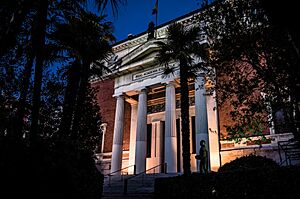
- Niceto Alcalá-Zamora
- Vicente Aleixandre
- Dámaso Alonso
- José "Azorín" Martínez Ruiz
- Vicente Bacallar y Sanna
- Pío Baroja
- Jacinto Benavente
- Carlos Bousoño
- Manuel Bretón de los Herreros
- Camilo José Cela
- Miguel Delibes
- José Echegaray
- Fernando Fernán Gómez
- Wenceslao Fernández Flórez
- Gaspar Melchor de Jovellanos
- Alicia Jurado
- Antonio Machado
- Salvador de Madariaga
- Julián Marías
- Francisco Martínez de la Rosa
- Ramón Menéndez Pidal
- Armando Palacio Valdés
- José María de Pereda
- Benito Pérez Galdós
- Manuel José Quintana
- Gonzalo Torrente Ballester
- Leonardo Torres Quevedo
- Juan Valera
- José Zorrilla
Learn More
See also
 In Spanish: Real Academia Española para niños
In Spanish: Real Academia Española para niños


